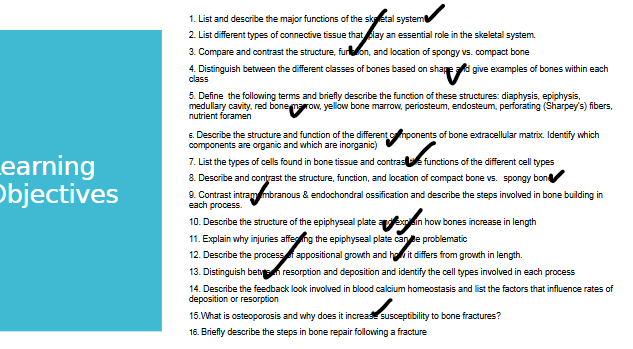Chapter 6- Bones
1/34
Earn XP
Description and Tags
Exam 2
Name | Mastery | Learn | Test | Matching | Spaced |
|---|
No study sessions yet.
35 Terms
major functions of skeletal system
protection, mineral storage, blood cell formation, fat storage
compact bone structure
osteon
structure of long bone
compact perimeter and spongy center with endosteum in between
regions of long bone
epiphysis on end and diaphysis in middle
what is the medullary cavity
location of red or yellow bone marrow in long bone
what is periosteum
outer connective layer of long bone
main types of connective tissue in bones
compact and spongy
where is yellow bone marrow found
limbs of adults storing fat, infants have none
what holds the periosteum in place
perforating fibers made up of collagen
what is tte nutrient foramen
openning for 1 nutrient artery to enter bone
types of bone classifications
long, short, irregular, flat, sesamoid
structure of spongy bone
trabeculae like maze lines
function of spongy bone
bone marrow production and shock absorption
main organic material of bone
osteoid made of mostly collagen that provide flexibility
main inorganic material of bone
hydroxyapatite mainly calcium and phosphorus that harden the matrix
role of osteoblast
deposit bone until they become osteocytes
what are osteocytes
mature bone cells
role of osteoclast
degrade and resorp bone
role of lucuna
store bone cells
role of central canal
house nerves and blood vessels
role of canaliculi
connect lucunae and central canal for transfer of nutrients
what type of ossification do most bones experience
endochondral
when does intramembranous ossification take place
many flat bones built on embryonic connective tissue model
how does endochondral ossification occur
osteoblats calcify cartilage and replace it with bone
how does intramembranous ossification occur
osteoblasts secrete organic material that calcifies to spongy and compact bone
what is osteoporosis
inadequate inorganic material in bones causing bone loss
where does growth occur in a bone
epiphyseal plate from division of chondrocytes
at which zone do chondrocytes divide in the epiphyseal plate
zone of proliferation
why is fracture at epiphyseal plate bad
could cause premature closure of plate
what is appositional growth
bone growing in diameter not length as circumferential lamella are added
what is bone depostition
osteoblasts putting down bone
what is bone resorption
osteoclast breaking down bone
what gland is activated when blood calcium level decreases
parathyroid gland releasing PTH

steps of bone repair after fracture
break, bleeding, hematoma, soft callus, bony callus, secondary bone
what is a hematoma
localized collection of blood outside of blood vessels